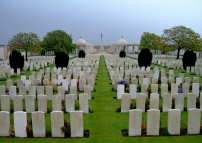| First Name: | Bertie | Last Name: | HUDSON | |
|---|---|---|---|---|
| Date of Death: | 25/09/1915 | Lived/Born In: | Brentford | |
| Rank: | Private | Unit: | Royal Fusiliers12 | |
| Memorial Site: | 1. Brentford Memorial 2. Loos Memorial, France | |||
Current Information:Age-33 51, George Road, Brentford The Battle of Loos This battle, fought by the British Army from 25th September, 1915 through to 13th October, was conducted along a six-and-a-half-mile front running north from the mining village of Loos on the outskirts of Lens in Northern France. It was the largest offensive carried out by the British so far. The opening day involved an attack by six divisions, with others entering the fray as it progressed and it was part of a much wider offensive with the French launching their own attacks in Champagne and at Vimy. It was the first time that the British used gas during the war, despite their condemnation of the Germans for doing the same in April 1915. There were some encouraging results on the first day but no major breakthrough was achieved and in the successive days of the battle it became bogged down in brutal trench warfare. By mid-October the battle had petered out with the British having suffered over 60,000 casualties during its course. The reserve Corps for the battle, XI Corps, was made up of the Guards Division and two New Army divisions, 21st Division and 24th Division, made up of volunteers who had responded to Kitchener’s appeal, and who had only arrived in France at the beginning of September 1915. Nevertheless they were soon in battle. Field Marshal French kept them back from the front when the main attack went in on 25th September but when things did not go to plan the reserves were urgently called for. Even so they were held back until the last minute which meant that they had to march across country through a night of heavy rain to reach the battlefield. It was not until the afternoon of 26th September that they were in position to assault the German second line between Bois Hugo & Hulluch. But by this time the enemy had brought up reserves and were launching counter attacks which further disrupted proceedings. What happened next was a disaster. Advancing in broad daylight in ten columns, without the help of an artillery barrage these totally inexperienced divisions were cut to pieces by machine gun and rifle fire. They lost half of their number in a matter of minutes. Even the Germans were shocked at the slaughter and stopped firing to allow the survivors to withdraw. 73 Brigade of 24th Division, made up of 13th Middlesex, 7th Northamptonshire, 12th Royal Fusiliers and 9th Sussex, were sent further north on the battlefield to relieve 26 Brigade of 9th Division around Fosse 8. Throughout the 25th September they had been labouring their way up to the old British trenches west of the Hohenzollern Redoubt, not fully arriving until 7pm. At 10pm, after a difficult journey into the unknown, extremely tired and across five lines of German trenches and other obstacles, 73 Brigade filed into Corons Alley Trench north-west of the Dump at Fosse 8. At 1am, whilst the relief was in progress, the Germans launched a counter attack but this was seen off by units of both Brigades. Those who got into the British line were seen off with bayonets. This German failure was said, by the Germans, to have happened because they cheered too early. 73 Brigade then took over the whole line from Fosse 8 to Fosse Alley. |
||||
| « Back to Search Results | ||||
| If you think any of the information shown here is incorrect, Click Here to submit your amends and comments | ||||




